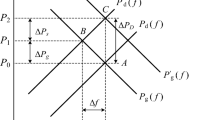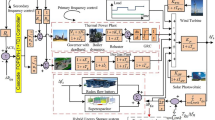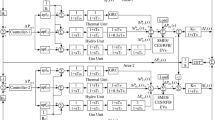Abstract
This paper investigates the use of energy storage devices (ESDs) as back-up sources to escalate load frequency control (LFC) of power systems (PSs). The PS models implemented here are 2-area linear and nonlinear non-reheat thermal PSs besides 3-area nonlinear hydro-thermal PS. PID controller is employed as secondary controller in each control area and ESDs such as battery energy storage system, flywheel energy storage system and ultra-capacitor are employed to assist LFC task during crest load disturbances. PID controller parameters are optimized by salp swarm algorithm (SSA) using a new cost function. This function is innovative, improving system stability by increasing stability margin of the system. Contribution of the proposed approach are thoroughly justified by contrasting it against the renowned works in the state-of-the-art. The comparison analysis clearly unveils that SSA optimized PID controller with ESDs is able to significantly reduce settling time and unwanted oscillations of frequency and tie-line power deviations with a greater stability margin. Our proposal is also more economic than the existing solutions considering the trade-off between simplicity and effectiveness.










Similar content being viewed by others
References
Çelik E (2020) Improved stochastic fractal search algorithm and modified cost function for automatic generation control of interconnected electric power systems. Eng Appl Artif Intell 88:103407
Cai S, Xie Y, Wu Q, Zhang M, Jin X, Xiang Z (2022) Active and reactive power coordinated two-stage MG scheduling for resilient distribution systems under uncertainties. IEEE Trans Smart Grid 13(4):2986–2998
Cai S, Zhang M, Xie Y, Wu Q, Jin X, Xiang Z (2022) Hybrid stochastic-robust service restoration for wind power penetrated distribution systems considering subsequent random contingencies. IEEE Trans Smart Grid 13(4):2854–2872
Dahiya P, Sharma V, Naresh R (2019) Optimal sliding mode control for frequency regulation in deregulated power systems with DFIG-based wind turbine and TCSC–SMES. Neural Comput Appl 31:3039–3056
Rosaline AD, Somarajan UK (2019) Structured H-infinity controller for an uncertain deregulated power system. IEEE Trans Ind Appl 55(1):892–906
Çelik E (2021) Design of new fractional order PI-fractional order PD cascade controller through dragonfly search algorithm for advanced load frequency control of power systems. Soft Comput 25:1193–1217
Arya Y, Dahiya P, Çelik E, Sharma G, Gözde H, Nasiruddin I (2021) AGC performance amelioration in multi-area interconnected thermal and thermal-hydro-gas power systems using a novel controller. Eng Sci Technol Int J 24(2):384–396
Arya Y, Kumar N, Dahiya P, Sharma G, Çelik E, Dhundhara S, Sharma M (2021) Cascade-IλDμN controller design for AGC of thermal and hydrothermal power systems integrated with renewable energy sources. IET Renew Power Gener 15(3):504–520
Rajesh KS, Dash SS, Rajagopal R (2019) Hybrid improved firefly-pattern search optimized fuzzy aided PID controller for automatic generation control of power systems with multi-type generations. Swarm Evol Comput 44:200–211
Saikia LC, Mishra S, Sinha N, Nanda J (2011) Automatic generation control of a multi area hydrothermal system using reinforced learning neural network controller. Int J Electr Power Energy Syst 33(4):1101–1108
Sharma D, Mishra S (2019) Non-linear disturbance observer-based improved frequency and tie-line power control of modern interconnected power systems. IET Gener Transm Distrib 13(16):3564–3573
Guha D, Roy PK, Banerjee S (2021) Disturbance observer aided optimised fractional-order three-degree-of-freedom tilt-integral-derivative controller for load frequency control of power systems. IET Gener Transm Distrib 15(4):716–736
Çelik E, Öztürk N (2018) First application of symbiotic organisms search algorithm to off-line optimization of PI parameters for DSP-based DC motor drives. Neural Comput Appl 30:1689–1699
Abd-Elazim SM, Ali ES (2018) Load frequency controller design of a two-area system composing of PV grid and thermal generator via firefly algorithm. Neural Comput Appl 30:607–616
Guha D, Roy PK, Banerjee S (2017) Study of differential search algorithm based automatic generation control of an interconnected thermal-thermal system with governor dead-band. Appl Soft Comput 52:160–175
Hota PK, Mohanty B (2016) Automatic generation control of multi source power generation under deregulated environment. Int J Electr Power Energy Syst 75:205–214
Yılmaz ZY, Bal G, Çelik E, Öztürk N, Güvenç U, Arya Y (2021) A new objective function design for optimization of secondary controllers in load frequency control. J Faculty Eng Archit Gazi Univ 36(4):2053–2067
Hasanien HM, El-Fergany A (2017) Symbiotic organisms search algorithm for automatic generation control of interconnected power systems including wind farms. IET Gener Transm Distrib 11(7):1692–1700
Guha D, Roy P, Banerjee S (2017) Quasi-oppositional symbiotic organism search algorithm applied to load frequency control. Swarm Evol Comput 33:46–67
Guha D, Roy PK, Banerjee S (2018) Application of backtracking search algorithm in load frequency control of multi-area interconnected power system. Ain Shams Eng J 9:257–276
Sahu RK, Panda S, Padhan S (2015) A hybrid firefly algorithm and pattern search technique for automatic generation control of multi area power systems. Int J Electr Power Energy Syst 64:9–23
Guha D, Roy PK, Banerjee S (2016) Load frequency control of interconnected power system using grey wolf optimization. Swarm Evol Comput 27:97–115
Mohanty B, Panda S, Hota PK (2014) Controller parameters tuning of differential evolution algorithm and its application to load frequency control of multi-source power system. Int J Electr Power Energy Syst 54:77–85
Singh SP, Prakash T, Singh VP, Babu MG (2017) Analytic hierarchy process based automatic generation control of multi-area interconnected power system using jaya algorithm. Eng Appl Artif Intell 60(2):35–44
Sivalingam R, Chinnamuthu S, Dash SS (2017) A hybrid stochastic fractal search and local unimodal sampling based multistage PDF plus (1+PI) controller for automatic generation control of power systems. J Franklin Inst 354:4762–4783
Padhy S, Panda S (2017) A hybrid stochastic fractal search and pattern search technique based cascade PI-PD controller for automatic generation control of multi-source power systems in presence of plug in electric vehicles. CAAI Trans Intell Technol 2:12–25
Satapathy P, Debnath MK, Mohanty MK (2018) Design of PD-PID controller with double derivative filter for frequency regulation. In: IEEE international conference on power electronics, intelligent control and energy systems, Delhi, India, pp 1142–1147
Rahman A, Saikia LC, Sinha N (2016) AGC of dish-Stirling solar thermal integrated thermal system with biogeography based optimised three degree of freedom PID controller. IET Renew Power Gener 10(8):1161–1170
Kler D, Kumar V, Rana KPS (2019) Optimal integral minus proportional derivative controller design by evolutionary algorithm for thermal-renewable energy-hybrid power systems. IET Renew Power Gener 13(11):2000–2012
Çelik E, Öztürk N, Arya Y, Ocak C (2021) (1 + PD)-PID cascade controller design for performance betterment of load frequency control in diverse electric power systems. Neural Comput Appl 33:15433–15456
Arya Y (2019) AGC of restructured multi-area multi-source hydrothermal power systems incorporating energy storage units via optimal fractional-order fuzzy PID controller. Neural Comput Appl 31:851–872
Selvaraju RK, Somaskandan G (2016) Impact of energy storage units on load frequency control of deregulated power systems. Energy 97:214–228
Shankar R, Chatterjee K, Bhushan R (2016) Impact of energy storage system on load frequency control for diverse sources of interconnected power system in deregulated power environment. Int J Electr Power Energy Syst 79:11–26
Sobhy MA, Abdelaziz AY, Hasanien HM, Ezzat M (2021) Marine predators algorithm for load frequency control of modern interconnected power systems including renewable energy sources and energy storage units. Ain Shams Eng J 12(4):3843–3587
Li J, Xiong R, Yang Q, Liang F, Zhang M, Yuan W (2017) Design/test of a hybrid energy storage system for primary frequency control using a dynamic droop method in an isolated microgrid power system. Appl Energy 201:257–269
Chatterjee A, Ghoshal SP, Mukherjee V (2012) Transient performance improvement of grid connected hydro system using distributed generation and capacitive energy storage unit. Int J Electr Power Energy Syst 43(1):210–221
Mirjalili S, Gandomi AH, Mirjalili SZ, Saremi S, Faris H, Mirjalili SM (2017) Salp swarm algorithm: a bio-inspired optimizer for engineering design problems. Adv Eng Softw 114:163–191
Hussien AG, Hassanien AE, Houssein EH (2017) Swarming behaviour of salps algorithm for predicting chemical compound activities. In: IEEE 8th international conference on intelligent computing and information systems, Cairo, Egypt, pp 315–320
Ekinci S, Hekimoglu B (2018) Parameter optimization of power system stabilizer via salp swarm algorithm. In: 5th International conference on electrical and electronic engineering, Istanbul, Turkey, pp 143–147
Mohapatra TK, Sahu BK (2018) Design and implementation of SSA based fractional order PID controller for automatic generation control of a multi-area, multi-source interconnected power system. In: Technologies for smart-city energy security and power, Bhubaneswar, India, pp 1–6
El-Fergany AA (2018) Extracting optimal parameters of PEM fuel cells using salp swarm optimizer. Renew Energy 119:641–648
Ismael S, Aleem S, Abdelaziz A, Zobaa A (2018) Practical considerations for optimal conductor reinforcement and hosting capacity enhancement in radial distribution systems. IEEE Access 6:27268–27277
Das DC, Roy AK, Sinha N (2012) GA based frequency controller for solar thermal-diesel-wind hybrid energy generation/energy storage system. Int J Electr Power Energy Syst 43:262–279
Häggström F, Delsing J (2018) IoT energy storage-A forecast. Energy Harvest Syst 5(3–4):43–51
Çelik E, Gör H (2019) Enhanced speed control of a DC servo system using PI+DF controller tuned by stochastic fractal search technique. J Franklin Inst 356:1333–1359
Çelik E, Öztürk N (2018) A hybrid symbiotic organisms search and simulated annealing technique applied to efficient design of PID controller for automatic voltage regulator. Soft Comput 22:8011–8024
Çelik E (2018) Incorporation of stochastic fractal search algorithm into efficient design of PID controller for an automatic voltage regulator system. Neural Comput Appl 30:1991–2002
Çelik E, Öztürk N, Bal G (2018) Design of PID controlled-automatic voltage regulator system based on a new neighborhood strategy of simulated annealing. In: 4th International conference on engineering and natural sciences, Kiev, Ukrayna, pp 174–181
Panda S, Mohanty B, Hota PK (2013) Hybrid BFOA-PSO algorithm for automatic generation control of linear and nonlinear interconnected power systems. Appl Soft Comput 13:4718–4730
Rout UK, Sahu RK, Panda S (2013) Design and analysis of differential evolution algorithm based automatic generation control for interconnected power system. Ain Shams Eng J 4(3):409–421
Sahu RK, Panda S, Rout UK, Sahoo DK (2016) Teaching learning based optimization algorithm for automatic generation control of power system using 2-DOF PID controller. Int J Electr Power Energy Syst 77:287–301
Sahu RK, Panda S, Sekhar GTC (2015) A novel hybrid PSO-PS optimized fuzzy PI controller for AGC in multi area interconnected power systems. Int J Electr Power Energy Syst 64:880–893
Gozde H, Taplamacioglu MC (2011) Automatic generation control application with craziness based particle swarm optimization in a thermal power system. Int J Electr Power Energy Syst 33(1):8–16
Mohanty B, Panda S, Hota PK (2014) Differential evolution algorithm based automatic generation control for interconnected power systems with non-linearity. Alex Eng J 53:537–552
Nanda J, Parida M, Kalam A (2006) Automatic generation control of a multi-area power system with conventional integral controllers. In: Australasian universities power engineering conference, Melbourne, Australia, pp 1–7
Author information
Authors and Affiliations
Corresponding author
Ethics declarations
Conflict of interest
The authors do not declare any conflict of interest.
Data availability
All the research data presented in the work can be reached when contacting with the author by email.
Additional information
Publisher's Note
Springer Nature remains neutral with regard to jurisdictional claims in published maps and institutional affiliations.
Appendix
Appendix
1.1 Nominal parameters of test system-1 are [1, 6, 49, 51, 52];
\(f=60\) Hz, \(B=0.425\) p.u MW/Hz, \(R=2.4\) Hz/pu, \({T}_{g}=0.03\) s, \({T}_{t}=0.3\) s, \({K}_{ps}=120\) Hz/pu, \({T}_{ps}=20\) s, \({T}_{12}=0.545\) p.u MW/rad.
1.2 Nominal parameters of test system-2 are [1, 6, 49, 51, 53];
\(f=60\) Hz, \(B=0.425\) p.u MW/Hz, \(R=2.4\) Hz/pu, \({T}_{g}=0.2\) s, \({T}_{t}=0.3\) s, \({K}_{ps}=120\) Hz/pu, \({T}_{ps}=20\) s, \({T}_{12}=0.444\) p.u MW/rad.
1.3 Nominal parameters of test system-3 are [1, 6, 49, 55];
\(f=60\) Hz, \(B=0.425\) p.u MW/Hz, \(R=2.4\) Hz/pu, \({T}_{g}=0.08\) s, \({K}_{r}=0.5\), \({T}_{r}=10\) s, \({T}_{t}=0.3\) s, \({K}_{p}=1.0\), \({K}_{d}=4.0\), \({K}_{i}=5.0\), \({T}_{w}=1\) s, \({K}_{ps}=120\) Hz/pu, \({T}_{ps}=20\) s, \({T}_{12}={T}_{23}={T}_{13}=0.086\) p.u MW/rad.
Rights and permissions
Springer Nature or its licensor holds exclusive rights to this article under a publishing agreement with the author(s) or other rightsholder(s); author self-archiving of the accepted manuscript version of this article is solely governed by the terms of such publishing agreement and applicable law.
About this article
Cite this article
Çelik, E., Öztürk, N. & Houssein, E.H. Improved load frequency control of interconnected power systems using energy storage devices and a new cost function. Neural Comput & Applic 35, 681–697 (2023). https://doi.org/10.1007/s00521-022-07813-1
Received:
Accepted:
Published:
Issue Date:
DOI: https://doi.org/10.1007/s00521-022-07813-1




